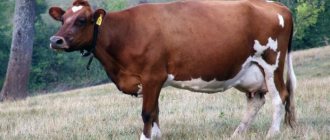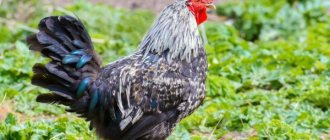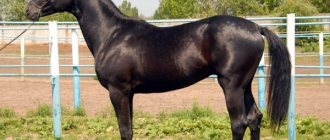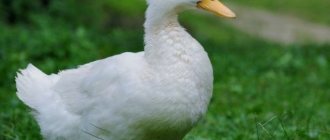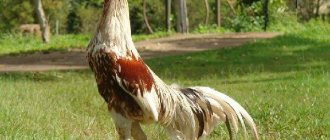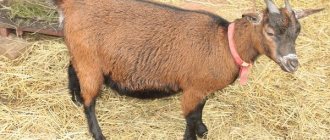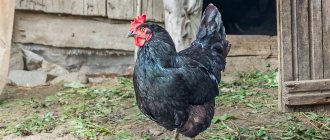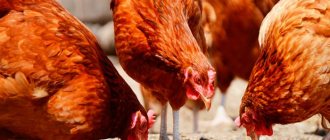Breeding history
There are three main colors for mini meat chickens:
- fawn
- white;
- red and black.
All three subspecies have the dwarfism gene. It was obtained through long-term selection and strict breeding work. To create the breed, Plymouth Rocks, Leghorns, Cornish, and Rhode Island dogs were used.
Mini meat cock
Today, preference is given to mini meat chickens to obtain:
- egg products;
- early ripening young;
- highly productive maternal stock. In this case, a producer belonging to a large meat breed is placed with the chickens. As a result, early ripening broiler young animals are born; their meat is classified as a gourmet product.
Meat breeds of chickens
Chickens of meat breeds have a fundamentally different body structure:
- large dimensions;
- compact fold;
- horizontally located torso;
- heavy skeleton.
In addition, these breeds are also distinguished by their rather soft and loose plumage, as well as their calm, absolutely non-conflicting character.
Meat chickens
Since the main focus of these chickens is considered to be meat production, they lay a very small number of eggs, which are only sufficient for further breeding of these birds.
Cornish chickens
Cornish chickens are descendants of the following two breeds of these birds:
- fighting English chickens;
- Malay individuals.
Cornish chicken
These two breeds eventually created a very remarkable specimen, not capable of producing eggs in large quantities, however, reaching a respectable body weight:
- 3.5 kilograms for females;
- 4.5 kilograms for roosters.
Chicks that are born are white in color. This breed is often used for breeding work aimed at breeding broilers.
Chickens of the Brahma breed
Chickens of this breed have several important differences in appearance:
- their scallop is almost undeveloped;
- legs are decorated with fluffy stockings;
- on the neck there is a collar of feathers, the color of which contrasts with the main plumage.
Brahma chickens
As for weight, chickens of this breed can gain a maximum weight equal to:
- 3.5 kilograms in females;
- 4 kilograms in males.
Brahma chickens are quite often bred by Russian farmers.
Chickens of the Cochin breed
This breed is also considered one of the most common meat breeds. Their live weight is:
- 5-6 kilograms for roosters;
- 4.5 kilograms for chickens.
At the same time, chickens of this breed produce fairly good-tasting eggs with brown shells.
Fluffy Cochin rooster
Cochin feather colors can be:
- black;
- white;
- beige;
- blue.
These birds are beautiful, graceful and very productive.
Productive characteristics
If crossing with a meat producer is not carried out, then purebred chickens will fatten well. According to the control indicators for weight gain, the following results can be observed:
| Month | Vespetukha | Veskurochki | Note |
| 2 months | 1 kg | 800–850 g | |
| 3 month | 1.7 kg | 1.5 kg | Livestock are culled if there is a significant deviation in weight and external characteristics |
| 4 months and older | 2.5 kg | 2.0 kg |
The maximum weight for a cockerel is 3 kg, for hens - 2.7 kg. Birds reach sexual maturity at the age of 6 months.
The white variety was obtained from the dwarf Leghorn breed. Chickens have universal productive qualities, and their egg production is almost equal to the best indicator inherent in the egg direction - approximately 180 pieces, average weight is 60 g.
Appearance
The body is compact with intensively developed muscles. Legs are short. The plumage is quite dense, making mini-chickens resistant to cold. The comb is small, classic leaf-shaped.
Be sure to read:
Photos and descriptions of decorative and dwarf breeds of chickens
Doesn't freeze in winter. Keeping individuals of different colors allows you to subsequently produce chickens of all colors existing in the breed.
Conditions of detention and care
The mini meat breed is distinguished by its size, which means that it does not require much space to keep them; the room can be made very small. There are no subtleties, it is important to follow the following principles:
- The mini meat breed is perfectly adapted to the climate of the middle zone. They don't have to build a heating system. But with the onset of winter, the owner will have to take care of additional lighting so that egg production remains at the level.
- There should be nests and perches in the room.
- The chicken coop must be provided with ventilation, but drafts must not be allowed to occur.
- The litter must be dry and clean. It is recommended to use hay, straw or sawdust for this purpose. It is necessary to systematically agitate the layer so that it does not cake, remove contaminated areas and add new layers as needed.
Chickens that are kept for meat production can be kept in a cage-based manner. They have a wonderful, calm character and therefore can live without walks. But it will still be better if the birds can spend some time in the walking yard to find pasture or fresh greens.
Subtleties of feeding
Mini meat chickens have universal productivity. This means that young animals need to be fed in the same way as broiler chickens. One chicken will need 130 g of feed per day.
To obtain a commercial weight carcass, you need to use high-quality feed that is rich in amino acids, vitamins and minerals, and is also nutritionally balanced.
The feeding diet is similar to the diet of the most common breed. But it is recommended to give chickens starter feed and then switch them to crushed grain mixture. It is necessary to use wet mash, green mass, bone meal and other additives for feeding.
Homemade poultry food should consist of three varieties:
- wet: mixtures based on potatoes (peels) with vegetables, root vegetables and herbs;
- dry: cereals with the addition of sand and chalk;
- mixed: a combination of the first two types of food.
Dry feeding is most often used. It does not require much time to prepare, and this food stores well. The simplest recipe for preparing such food is to mix barley, oats, corn and millet in equal parts. Add grated chalk.
To prepare wet food you should prepare:
- potato;
- pumpkin;
- beet;
- cabbage;
- zucchini and cucumbers.
Did you know? One of the most ancient and famous logical riddles, a definite answer to which has not yet been found: which comes first, the egg or the chicken. Aristotle discussed this dilemma in 384 BC. e.
Grind all ingredients using a grater. Make small portions, since such salads cannot be stored for more than two days. Also, you should not place too much emphasis on wet food, as this can cause gastrointestinal upset. For winter nutrition, the proportion of vitamins and microelements in the feed should be increased.
If you do not use ready-made factory-made mixtures, then you should prepare the components for winter feeding in the summer:
- Prepare potatoes and melons, they last quite a long time. They are fed in mixtures or simply chopped.
- Prepare hay from the summer. They need to periodically line the bottom of the coop. Birds love to rummage through it.
- Stock up on fine gravel, it promotes normal digestion of the bird.
Particular attention should be paid to feeding chickens. They need balanced feeding from the very first days of life. Improper feeding can lead to deformed toes in chicks after the first week of life.
This is explained by the fact that the dwarf gene was used during selection, the presence of which requires balanced feeding from a very early age.
Some rules for feeding young animals:
- Give your chickens fermented milk products with herbs.
- After the first month of life, introduce mixed feed and bone meal into the diet.
- Once the chicken reaches five months of age, you need to start feeding it adult bird food.
Subtleties of breeding
The dwarf trait is recessive, which means that mini meat chickens can only be bred among themselves. To prevent unwanted mutation, the parent stock is diluted with unrelated young stock from replacement.
Mini meat cock
Private breeders often use the breed to produce early maturing young animals. You can use a Cornish breeder and after a few weeks lay the eggs under the hen or in an incubator.
A standard flock consists of one rooster and 10 laying hens. The fertilization of eggs reaches 95%, but the young are hatched from approximately 80% of the material. After hatching, the chickens are placed in a warm room with a temperature of +34 to +36 degrees and this figure is gradually increased to +18–20 degrees.
Feeding
Mini meat birds have universal productivity indicators, despite their name. Therefore, all the principles of feeding young animals that are raised for meat will differ from the nutrition of laying hens.
One dwarf chicken requires about 140 grams of feed per day.
In order for the carcass to grow as quickly as possible, it is recommended to use high-quality combined feed for industrial use.
They maintain a balance and the required amount of minerals, acids and vitamins. The entire composition must be carefully balanced and provide all the needs of the bird.
Laying hens eat like regular chickens. The only difference is that the chickens are raised on a starter-type combined feed, then they are gradually accustomed to crushed grain mixtures. It is important to use wet food, grass, meat and bone meal. Other additives are also allowed.
About the advantages and disadvantages
| pros | Minuses |
| Young animals grow rapidly | Due to their short paws, in damp weather they often touch their stomachs on wet ground, which leads to illness. It is not recommended to let him go for a walk in the damp. |
| Not picky about food supply | There are a number of problems with the limbs. They begin with a poorly balanced diet, especially in young animals. |
| It is fashionable to use cage and aviary housing | |
| Large egg products | |
| Do not tear up plantings if they are walking in an unfenced area | |
| Doesn't require much storage space | |
| Calm character |
Famous groups
At the moment, among all individuals of the mini-meat breed, several lines are distinguished that can be identified by color, as well as body features.
Table 1. Groups of mini-meat breeds
| Name | Description |
| B66 | Representatives of the group have the entire set of features characteristic of meat birds - powerful bones, muscular physique and developed chest. The plumage color of B66 chickens can only be white. If there are inclusions of other colors on the feathers, a defect occurs. Such individuals are not used for further reproduction. |
| B77 | B77 chickens are in many ways similar to the chickens of the group described above. The main difference is the color of these individuals - unlike B66, B77 has golden feathers protruding against a white background |
| B76 | Chickens of group B76 are the product of crossing the two groups described above, and therefore inherit two directions at once. In such chickens, the feathers most often have a white tint with fawn splashes along the entire body |
| P11 | Chickens of the P11 group appeared as a result of the participation of the Rhode Island breed, which provided these individuals with a rich red plumage color. Like all other individuals of the mini-meat breed, they have a strong build and short but strong legs |
| M33 | The chickens of the M33 group were based on the leghorn genotype, with which the resulting individuals have many common features. Chickens have snow-white plumage, but the young are born with yellow feathers. It is believed that chicks of the M33 group have excellent immunity |
Regarding the characteristics of productivity and established habits, the described groups do not have significant differences from each other. Therefore, if you want to purchase individuals of the mini-meat breed, keep in mind that the color of the plumage does not affect performance characteristics or any other parameters.
Productivity
Mini meat chickens have the following characteristics:
- weight: chicken - 2.7 kg, cockerel - 3 kg;
- egg production - up to 170 eggs per year;
- egg weight - 57-60 g;
- chick survival rate is over 97%, with proper care it can reach 99%;
- hatchability of chickens - about 84%;
- survival rate of adult birds is over 90%.
Did you know? The first domestic chickens appeared on the territory of modern Ethiopia at the turn of the 1st and 2nd millennia BC.
How to choose a mini chicken to buy
An adult bird is selected for purchase from a poultry farm or from friends and neighbors. You should not buy from strangers in markets: unscrupulous people may offer sick chicken. The disease in the incubation stage cannot be determined by eye, but such a chicken can infect others in the farmstead.
It is better to purchase livestock from a specialized poultry farm. In many regions there are farms that breed these breeds for sale. There are no sick birds there, as the owners carefully monitor the health of their pets. The addresses of such farms can be found from familiar poultry farms or found on the Internet.
You cannot keep chickens of different colors on the same farm. Crossing breeds is possible, but in addition to the appearance of new colors in the plumage, this will negatively affect the health of the offspring. Survival rates will decrease and chicks will be smaller in size.
Reproduction
Mini meat hens are excellent hens, so they hatch eggs well and take care of chickens. If you purchase a Cornish cockerel, you can get snow-white broilers. But experienced poultry farmers do not recommend spoiling the gene pool of mini meat chickens, as they may lose their declared standards and subsequently purebred chickens.
Reference! When crossing a mini-meat chicken with a cockerel of another breed, the offspring can often and for a long time get sick, since the bird’s immune system suffers first of all, and the young animals can be frail and grow poorly.
Despite the fact that hens are excellent hens, there may be some individuals who do not want to hatch their offspring at all. Therefore, if you want to ensure uninterrupted output for yourself or for sale, then it is better to purchase incubators.
A good incubator will turn the eggs independently and maintain optimal temperature and humidity. The hatched chickens are left in the incubator until they are completely dry , then they are transplanted into a box with additional illumination from an infrared lamp.
In general, breeding a mini-meat breed will not be difficult, since the survival rate of young animals and the fertility of eggs is at a high level.
general description
Dwarf forms of chickens are common in European countries. The birds have the qualities of every famous breed that is loved to be raised on home-type farms. As an example, they highlight Cochin and Brama. Dwarfs will vary in size.
Meat small chickens with a corpulent body, which is inherent in representatives of meat breeds. The lower limbs are short, plus they are one third smaller in comparison with large representatives of the breed.
All varieties have dense plumage and a leaf-shaped comb. If you place chickens of different colors in a herd, unusual varieties of feather colors are born:
- striped;
- smoky;
- calico;
- black.
What diseases are you susceptible to?
All diseases are divided into three groups:
- infectious;
- viral;
- parasitic.
The most dangerous infectious diseases of chickens:
- pesterellosis (bird cholera);
- pullorosis (typhoid fever caused by a disorder of the gastrointestinal tract);
- pasteurrelosis (caused by special microorganisms - pasteurrelosis);
- salmonellosis (avian paratyphoid fever);
Dangerous viral diseases:
- Marek's disease (neurolymphatosis or infectious paralysis);
- infectious bronchitis (nephrosophritis, affecting the respiratory tract and kidneys);
- bird flu (respiratory infection);
- chicken pox (a viral infection that affects the skin, the inside of the beak, and the cornea of the eyes).
For the most part, chickens have the same diseases, and it doesn’t matter whether you have laying hens or a meat breed. The most dangerous diseases for poultry are contagious diseases, because they are very difficult to cure. Parasitic diseases:
- coccidosis (bloody diarrhea, infection caused by coccidia microorganisms);
- colibacillosis (infection caused by E. coli);
- mycoplasmosis (respiratory infection caused by mycoplasma);
- helminths (lead to loss of appetite and stomach upset, which causes weight loss).
Birds are also plagued by external parasites: feather mites, lice eaters, and fleas. They make them nervous; affected individuals can pull out their feathers and itch. Laying hens reduce productivity and lose weight.
Disease prevention includes strict adherence to sanitary rules and mandatory vaccination. At the first symptoms of the disease, you need to isolate the sick birds and consult a veterinarian.
Distinctive features
- First of all, the distinctive and main feature of such chickens is their rapid growth. Despite the fact that the bird eats little compared to other breeds of chickens, it gains weight much faster than its peers in age, but of a different breed. On average, after 2 months, cockerels can gain weight up to 2 - 2.5 kg, and hens - 1-1.5 kg. And there are breeds of mini-meat chickens that can reach 3 or more kg at this age.
- They are undemanding when it comes to types of feed. They feel great if they consume regular feed mixtures, both specialized ones and those mixed by hand. This breed of chickens is also characterized by high digestibility of food and fast metabolism, which is why they consume little feed. And their breeding becomes profitable and inexpensive for the poultry farmer.
- These chickens also differ in that they are kept primarily in cages. About 10-11 chickens can be planted per 1 square meter. But they will also feel great free-range in the chicken coop. To prevent various diseases, it is worth keeping clean both in the cages and throughout the chicken coop, since chickens react very sharply to any disease. This is due to the special physiology of these birds.
